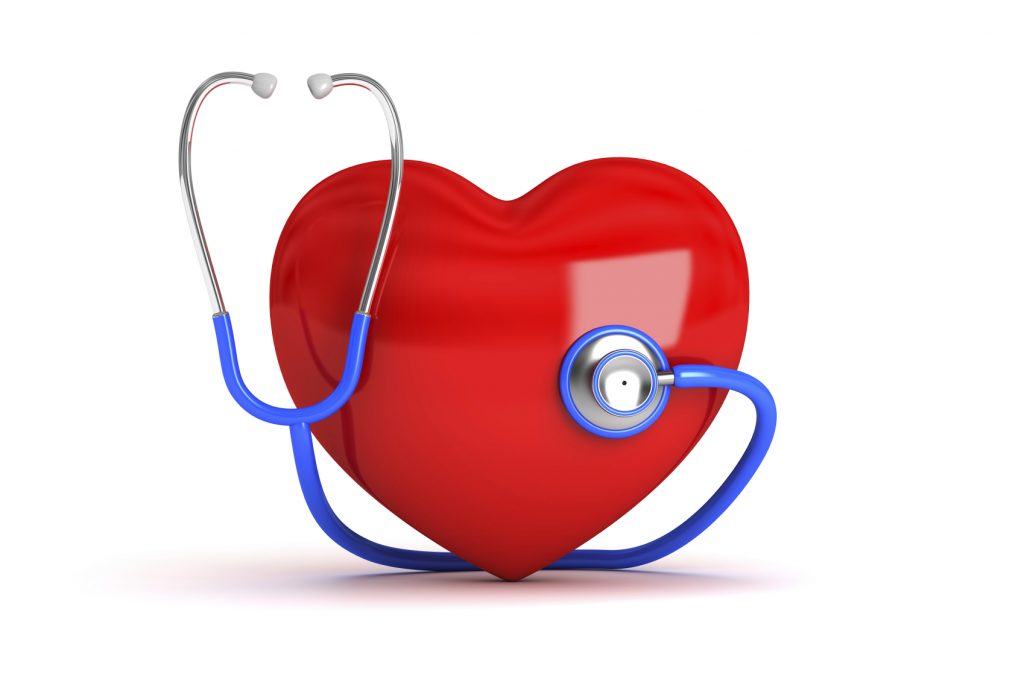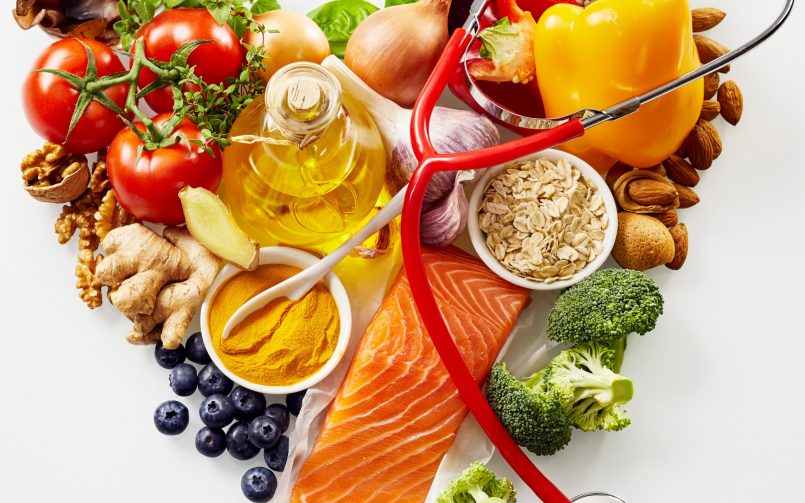Although you might know that eating certain foods can increase your heart disease risk, changing your eating habits is often tough. Whether you have years of unhealthy eating under your belt or you simply want to fine-tune your diet, here are eight heart-healthy diet tips. Once you know which foods to eat more of and which foods to limit, you’ll be on your way toward a heart-healthy diet.

1. Control your portion size
How much you eat is just as important as what you eat. Overloading your plate, taking seconds and eating until you feel stuffed can lead to eating more calories than you should. Portions served in restaurants are often more than anyone needs.
Following a few simple tips to control food portion size can help you shape up your diet as well as your heart and waistline:
- Use a small plate or bowl to help control your portions.
- Eat more low-calorie, nutrient-rich foods, such as fruits and vegetables
- Eat smaller amounts of high-calorie, high-sodium foods, such as refined, processed or fast foods.
It’s also important to keep track of the number of servings you eat. Some things to keep in mind:
- A serving size is a specific amount of food, defined by common measurements such as cups, ounces or pieces. For example, one serving of pasta is about 1/3 to 1/2 cup, or about the size of a hockey puck. A serving of meat, fish or chicken is about 2 to 3 ounces, or about the size and thickness of a deck of cards.
- The recommended number of servings per food group may vary depending on the specific diet or guidelines you’re following.
- Judging serving size is a learned skill. You may need to use measuring cups and spoons or a scale until you’re comfortable with your judgment.
2. Eat more vegetables and fruits
Vegetables and fruits are good sources of vitamins and minerals. Vegetables and fruits are also low in calories and rich in dietary fiber. Vegetables and fruits, like other plants or plant-based foods, contain substances that may help prevent cardiovascular disease. Eating more fruits and vegetables may help you cut back on higher calorie foods, such as meat, cheese and snack foods.
Featuring vegetables and fruits in your diet can be easy. Keep vegetables washed and cut in your refrigerator for quick snacks. Keep fruit in a bowl in your kitchen so that you’ll remember to eat it. Choose recipes that have vegetables or fruits as the main ingredients, such as vegetable stir-fry or fresh fruit mixed into salads.
3. Select whole grains

Whole grains are good sources of fiber and other nutrients that play a role in regulating blood pressure and heart health. You can increase the amount of whole grains in a heart-healthy diet by making simple substitutions for refined grain products. Or be adventuresome and try a new whole grain, such as whole-grain farro, quinoa or barley.
4. Limit unhealthy fats
Limiting how much saturated and trans fats you eat is an important step to reduce your blood cholesterol and lower your risk of coronary artery disease. A high blood cholesterol level can lead to a buildup of plaques in the arteries, called atherosclerosis, which can increase the risk of heart attack and stroke.
The American Heart Association offers these guidelines for how much fat to include in a heart-healthy diet:
*Note: The 2020-2025 Dietary Guidelines for Americans recommend limiting saturated fat to less than 10% of total daily calories.
There are simple ways to cut back on saturated and trans fats:
- Trim fat off meat or choose lean meats with less than 10% fat.
- Use less butter, margarine and shortening when cooking and serving.
- Use low-fat substitutions when possible for a heart-healthy diet. For example, top a baked potato with low-sodium salsa or low-fat yogurt rather than butter, or use sliced whole fruit or low-sugar fruit spread on toast instead of margarine.
Check the food labels of cookies, cakes, frostings, crackers and chips. Not only are these foods low in nutritional value, some — even those labeled reduced fat — may contain trans fats. Trans fats are no longer allowed to be added to foods, but older products may still contain them. Trans fats may be listed as partially hydrogenated oil on the ingredient label.
When you do use fats, choose monounsaturated fats, such as olive oil or canola oil. Polyunsaturated fats, found in certain fish, avocados, nuts and seeds, also are good choices for a heart-healthy diet. When used in place of saturated fat, monounsaturated and polyunsaturated fats may help lower your total blood cholesterol. But moderation is essential. All types of fat are high in calories.
An easy way to add healthy fat (and fiber) to your diet is to use ground flaxseed. Flaxseeds are small brown seeds that are high in fiber and omega-3 fatty acids. Studies have shown that flaxseed lowers unhealthy cholesterol levels in some people. You can grind the flaxseeds in a coffee grinder or food processor and stir a teaspoon of them into yogurt, applesauce or hot cereal.
5. Choose low-fat protein sources
Lean meat, poultry and fish, low-fat dairy products, and eggs are some of the best sources of protein. Choose lower fat options, such as skinless chicken breasts rather than fried chicken patties and skim milk rather than whole milk.
Fish is a good alternative to high-fat meats. Certain types of fish are rich in omega-3 fatty acids, which can lower blood fats called triglycerides. You’ll find the highest amounts of omega-3 fatty acids in cold-water fish, such as salmon, mackerel and herring. Other sources are flaxseed, walnuts, soybeans and canola oil.
Legumes — beans, peas and lentils — also are good, low-fat sources of protein and contain no cholesterol, making them good substitutes for meat. Substituting plant protein for animal protein — for example, a soy or bean burger for a hamburger — will reduce fat and cholesterol intake and increase fiber intake.
6. Limit or reduce salt (sodium)
Eating too much salt can lead to high blood pressure, a risk factor for heart disease. Limiting salt (sodium) is an important part of a heart-healthy diet. The American Heart Association recommends that:
- Healthy adults have no more than 2,300 milligrams (mg) of sodium a day (about a teaspoon of salt)
- Most adults ideally have no more than 1,500 mg of sodium a day
Although reducing the amount of salt you add to food at the table or while cooking is a good first step, much of the salt you eat comes from canned or processed foods, such as soups, baked goods and frozen dinners. Eating fresh foods and making your own soups and stews can reduce the amount of salt you eat.
If you like the convenience of canned soups and prepared meals, look for ones with no added salt or reduced sodium. Be wary of foods that claim to be lower in sodium because they are seasoned with sea salt instead of regular table salt — sea salt has the same nutritional value as regular salt.
Another way to reduce the amount of salt you eat is to choose your condiments carefully. Many condiments are available in reduced-sodium versions. Salt substitutes can add flavor to your food with less sodium.

7. Plan ahead: Create daily menus
Create daily menus using the six strategies listed above. When selecting foods for each meal and snack, emphasize vegetables, fruits and whole grains. Choose lean protein sources and healthy fats, and limit salty foods. Watch your portion sizes and add variety to your menu choices.
For example, if you have grilled salmon one evening, try a black bean burger the next night. This helps ensure that you’ll get all of the nutrients the body needs. Variety also makes meals and snacks more interesting.
8. Allow yourself an occasional treat
Allow yourself an indulgence every now and then. A candy bar or handful of potato chips won’t derail your heart-healthy diet. But don’t let it turn into an excuse for giving up on your healthy-eating plan. If overindulgence is the exception, rather than the rule, you’ll balance things out over the long term. What’s important is that you eat healthy foods most of the time.
Include these eight tips into your life, and you’ll find that heart-healthy eating is both doable and enjoyable. With planning and a few simple substitutions, you can eat with your heart in mind.